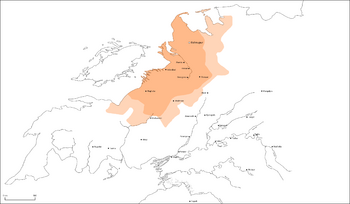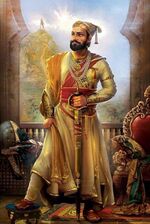Naratha Confederacy
Naratha Confederacy | |||||||||||||||||||||
|---|---|---|---|---|---|---|---|---|---|---|---|---|---|---|---|---|---|---|---|---|---|
| 1635–1847 | |||||||||||||||||||||
|
Military Banner (1635-1662) Confederate Flag (1662-1847) | |||||||||||||||||||||
 The Naratha Confederacy in 1784 | |||||||||||||||||||||
 The change of territory of the Naratha Confederacy | |||||||||||||||||||||
| Status | Confederation | ||||||||||||||||||||
| Capital | Bishnupur (from 1662) | ||||||||||||||||||||
| Common languages | Matrabashi | ||||||||||||||||||||
| Government | Confederal, elective monarchy | ||||||||||||||||||||
| Senpati | |||||||||||||||||||||
• First | Ashok I | ||||||||||||||||||||
• Last | Ashok II | ||||||||||||||||||||
| Chhatrapati | |||||||||||||||||||||
• First | Ashok II | ||||||||||||||||||||
• Last | Kishore III | ||||||||||||||||||||
| Legislature | Sanghasabha | ||||||||||||||||||||
| Historical era | Togoti Era | ||||||||||||||||||||
• Vichalan Accords | 1635 | ||||||||||||||||||||
• Treaty of Bishnupur | 1662 | ||||||||||||||||||||
• Southern Conquest | 1684 | ||||||||||||||||||||
• Fall of Zulmat | 1776 | ||||||||||||||||||||
• The Great Betrayal | 18xx | ||||||||||||||||||||
• Euclean Invasions | 18xx | ||||||||||||||||||||
• Collapse | 1847 | ||||||||||||||||||||
| Currency | Multiple Naratha Rupee (₹) (from 1683) | ||||||||||||||||||||
| |||||||||||||||||||||
| Today part of | |||||||||||||||||||||
The Naratha Confederacy (Matrabashi: Naratha Sangharsh) was a multi-ethnic complex of polities in north-western Satria that developed during the Togoti Era and continued until its collapse in 1847. From its establishment in 1635 to its collapse, the Confederacy was dominated by three nations - Sanyukt, Rathankot and Zulmat – with the Sanyukt ofen dominating the politics and leadership of the Confederacy. The core of the confederacy remained intact throughout its existence but its peripheral borders would change considerably throughout the lifespan of the Naratha Confederacy. Following the Treaty of Bishnupur - which saw the secession of nations of the lowlands, consolidation of power in the newly created position of Chhtrapati, and centralisation of the confederate government in the new capital of Bishnupur - the borders of the Confederacy remained relatively unchanged until its dissolution in 1847.
The Chhtrapatis were never able to achieve complete political unification for the Confederacy, with most domestic policy conducted by the member states of the Confederacy. In the final decades of the Confederacy, there was an increased decentralisation of power from Bishnupur due to internal power struggles between the Sanyukti, Rathani and Zulmati blocks of the confederacy. The extent of the power of the Chhtrapati varied depending on the holder of the office, their control over the bureaucracy and their relationships with the leaders of the member states. The office of Senpati, and later Chhtrapati, was an elective position through the leaders of the member states and was charged with managing the defence and foreign policy of the Confederacy. From the creation of the role of Chhtrapati to the collapse of the Confederacy, the Chhtrapati would be crowned by the High Priest (Panditrao) of Bishnupur. Despite them being elective positions, the Senpati, and later the Chhtrapati, were always the leaders of Sanyukt due to the economic, military and diplomatic influence and strength of Sanyukt. This continued domination of the political and military leadership of the Confederacy would be a continual matchstick for the tensions between the Sanyuktis and Rathanis throughout the confederate period.
Etymology
The term Naratha Confederacy was first used to describe the Confederacy in 1640, five years after its formation. It was officially adopted as the name of the Confederacy in 1640 by Senpati XX to further inspire unity and develop a shared sense of identity and culture. The Naratha river basin is home to the majority of member states of the Confederacy and is an area of significant cultural and linguistic development which has resulted in many of the nations within its basin having a shared sense of identity and culture. Prior to 1640, the Confederacy was simply termed as "the Sangharsh", the matrabashi word for Confederacy.
Whilst the member states of the confederacy had a shared culture and identity, with many using the same language, there was no sense of a united confederate identity with citizens identifying more with their member states rather than with the confederacy as a whiole. As a result, there was no term used to describe a 'confederate citizen'. Historians have typically referred to them as "Citizens of the Confederacy" or by using the denonyms for their respective nations. Only until the beginning of the Euclean invasions did the idea of a unified national identity emerge.
History
Senpati Period
The Naratha Confederacy was a loose coalition of independent nations that had come together in 1635 in response to the rising threat posed by the expanding Togoti Khaganate under Khagan Gurkhan. The confederacy’s largest powers, Sanyukt, Rathankot and Zulmat, took charge of military affairs due to their experience, leadership and efficiency. Over the next few decades, Sanyukt would emerge as the dominant power with its leader constantly being chosen by the nations to be the Senapati (transl. commander in chief). In response to growing delays and issues regarding military procurement, conscription and funding, the Senpati would begin to take over more and more duties that would have been left to the member states. This growing influence would sow discontent amongst the leadership of the member states but the resulting victories in the war would earn the Senpati favour amongst the common folk. When the Togoti Khaganate collapsed in 1665, the Senpati was exercising control over military, diplomatic, financial and bureaucratic affairs, with the latter enabling them to further reduce the powers of the member state governments. The Senpati would utilise the vast network of tulyatan monastaries as a bureaucratic network that would help them ensure control over local populations. Upon the conclusion of the Confederate-Khaganate war, the Senpati was self-proclaimed as the Chhatrapati in the Treaty of Bishnupur and the Confederacy began its transition towards a federation with a centralisation of power in the new Chhatrapati.
The Treaty of Bishnupur would, however, see the secession of several member states in the lowlands which were more culturally alligned with the Rajadom of Akdoğan. Following the collapse of the Togoti Khaganate, the Rajadom of Akdoğan rapidly increased its influence and power in Satria and had begun to exert pressure on the lowland member states of the confederacy. Not seeking to pose a threat to the rising Rajadom, many lowland member states of the confederacy opted to secede from the confederacy in an attempt to stay neutral and avoid war. However, during the Chhatrapati Period, the Rajadom and Confederacy would engage in a series of conflicts later known as the Confederate-Akdoğani Wars.
Chhatrapati Period

The first Chhatrapati, Ashoka II, was not only a skilled warrior and military strategist, but was also a master politician who had mastered the bureaucratic system, developed personal relationships with most of the member state leaders and had ensured a propaganda effort never before seen to promote his rule. His skills allowed him to rule the Confederacy as an almost unitary state, developing a single currency, reintroducing the bureaucratic systems that had existing during the dynastic and ganga sangh periods, which utilised the tulyatan monastaries, and diversified the government by appointing not only Sanyukti nobles but nobles from across the confederacy.
After the death of Ashoka II in 1689, his son and successor, Shivaji IV, was able to maintain much of what his father had accomplished and over his 32-year reign he would continue the work of trying to transform the still autonomous member states into a single state. Near the end of his reign, however, many of the leaders of the member states that had been around during the age of Ashoka II had now died and their successors were not as tied to the confederate regime. The collapse of a common enemy had taken away a unifying enemy for the member states and a lack of personal relations, growing resentment amongst the nobility over the role of the Sanyukti Chhatrapati and distrust over military reforms, which sought to further unify and keep employed a military during peacetime, resulted in the sowing of discontent and secession.
By 1775, despite significant economic improvements, the leaders of the member states had had enough of Sanyukti rule and many began to refuse paying their taxes to the Sanyukti Chhatrapati. In 1774, the Sultanate of Zulmat refused taxation payments to the Confederate Government and withdrew from the military alliance. Its irfanic leaders had grown increasingly infuriated by the tulyatan-dominated leadership of the confederacy and the priestly bureaucracy that was now threatening irfanic rule over the still tulyatan-majority Zulmat sultanate. Zulmat still remained a member of the confederacy but its attempts at secession had weakend its security and in 1776 the Zemani Empire launched and successfully invaded the Zulmat Sultanate. Following this, the Empire and Confederacy would enter into a period of war and peace which would last until the Euclean invasion. The threat of a new enemy in the form of the Zemani Empire helped reunite the Confederacy.
Decline of the Confederacy
Under the weak leadership of Kishor III, a new separatist crisis emerged and continued to grow throughout the early 19th Century. In an attempt to preserve the confederacy which had helped Rathankot prosper economically, its Raja orchestrated a palace coup against Chhatrapati Kishore III. The bloody coup saw the execution of dozens of high-ranking military officers, both Sanyukti and Rathani, as well as civil servants, by the Rathankot Raja’s men as many, despite being rathani, remained loyal to the Chhatrapati. The King installed himself as the new Chhatrapati and in a bid to ensure his control over Sanyukt, ordered the arrest and execution of the Sanyukti royal family to produce a power vaccum in which he would stand alone. The plan backfired when news reached the Sanyukti family and they fled from the confederate capital of Bishnupur to their ancient capital of Kinadica. Within a few weeks, the confederacy erupted into civil war with some recognising the authority of the Rathani Chhatrapati and others recognising the Sanyukti Chhatrapati. The civil war would significantly weaken the once great confederacy, allowing the Etrurian and Gaullican colonial empires to conquer and expand rapidly in the mid-19th century.


